Influence of Fine Crystal Percentage on the Electrical Properties of ZnO Ceramic-Based Varistors
Abstract
1. Introduction
2. Experimental Details
2.1. Preparation
2.2. Characterizations
3. Results and Discussion
3.1. Structural Analysis of ZnO Nanomaterials
3.2. I–V Characteristics
3.3. Electrical Conductivity
3.4. Discussion
4. Conclusions
Author Contributions
Funding
Acknowledgments
Conflicts of Interest
References
- Meng, P.; Yuan, C.; Xu, H.; Wan, S.; Xie, Q.; He, J.; Zhao, H.; Hu, J.; He, J. Improving the protective effect of surge arresters by optimizing the electrical property of ZnO varistors. Electr. Power Syst. Res. 2020, 178, 106041. [Google Scholar] [CrossRef]
- Cao, W.; Xie, X.; Wang, Y.; Chen, M.; Qiao, Y.; Wang, P.; Zhang, Y.; Liu, J. Effect of Pr6O11 doping on the microstructure and electrical properties of ZnO varistors. Ceram. Int. 2019, 45, 24777–24783. [Google Scholar] [CrossRef]
- Roy, S.; Roy, T.K.; Das, D. Grain growth kinetics of Er2O3 doped ZnO-V2O5 based varistor ceramics. Ceram. Int. 2019, 45, 24835–24850. [Google Scholar] [CrossRef]
- Higashi1, Y.; Koga, E. Barrier formation of single junctions with oxidation in SrCoO3-doped ZnO varistors sintered in a reducing atmosphere. J. Ceram. Soc. Jpn. 2019, 127, 912–917. [Google Scholar] [CrossRef]
- Dooho, C. The Transmittance Modulation of ZnO/Ag/ZnO Flexible Transparent Electrodes Fabricated by Magnetron Sputtering. J. Nanosci. Nanotechnol. 2020, 20, 379–383. [Google Scholar]
- Huong, V.; Resende, N.J.; Fontanals, T.D.P.N.; Jiménez, C. Low-cost fabrication of flexible transparent electrodes based on Al doped ZnO and silver nanowire nanocomposites: Impact of the network density. Nanoscale 2019, 11, 12097. [Google Scholar]
- Hsueh, T.J.; Peng, C.H.; Chen, W.S. A transparent ZnO nanowire MEMS gas sensor prepared by an ITO microheater. Sens. Actuators B Chem. 2020, 304, 127319. [Google Scholar] [CrossRef]
- Zada, A.; Khan, M.; Qureshi, M.N.; Liu, S.; Wang, R. Accelerating photocatalytic hydrogen production and pollutant degradation by functionalizing g-C3N4 with SnO2. Front. Chem. 2020, 7, 941. [Google Scholar] [CrossRef]
- Lee, S.H.; Sohn, C.K.; Djafar, A. Electrical properties and microstructure of ZnO varistor with high surge protective characteristics. J. Ceram. Process. Res. 2019, 20, 164–168. [Google Scholar]
- Obe, F.; Sato, Y.; Yamamoto, T.; Ikuhara, Y.; Sakuma, T. Current–voltage characteristics of cobalt-doped inversion boundaries in zinc oxide bicrystals. J. Am. Ceram. Soc. 2004, 86, 1616–1618. [Google Scholar] [CrossRef]
- Zhou, Z.; Kato, K.; Komaki, T.; Yoshino, M.; Yukawa, H.; Morinaga, M.; Morita, K. Effects of dopants and hydrogen on the electrical conductivity of ZnO. J. Eur. Ceram. Soc. 2004, 24, 139–146. [Google Scholar] [CrossRef]
- Gupta, T.K. Microstructural engineering through donor and acceptor doping in the grain and grain boundary of a polycrystalline semiconducting ceramic. J. Mater. Res. 1992, 7, 3280–3295. [Google Scholar] [CrossRef]
- Inada, M. Formation mechanism of non-ohmic zinc oxide ceramics. Jpn. J. Appl. Phys. 1980, 19, 409. [Google Scholar] [CrossRef]
- Olsson, E.; Dunlop, G.L.; Österlund, R. Development of functional microstructure during sintering of a ZnOvaristor material. J. Am. Ceram. Soc. 1993, 76, 65–71. [Google Scholar] [CrossRef]
- Nahmand, C.W.; Shin, B.C. Highly stable nonlinear properties of ZnO–Pr6O11–CoO–Cr2O3–Y2O3-based varistor ceramics. Mater. Lett. 2003, 57, 1322–1326. [Google Scholar]
- Peiteado, M.; de la Rubia, M.A.; Velasco, M.J.; Valle, F.J.; Caballero, A.C. Bi2O3 vaporization from ZnO-based varistors. J. Eur. Ceram. Soc. 2005, 25, 1675–1680. [Google Scholar] [CrossRef]
- Zada, A.; Muhammad, P.; Ahmad, W.; Hussain, Z.; Ali, S.; Khan, M.; Khan, Q.; Maqbool, M. Surface Plasmonic-Assisted Photocatalysis and Optoelectronic Devices with Noble Metal Nanocrystals: Design, Synthesis, and Applications. Adv. Funct. Mater. 2019, 30, 1906744. [Google Scholar] [CrossRef]
- Qiabc, K.; Xinga, X.; Zada, A.; Li, M.; Wang, Q.; Liu, S.; Lin, H.; Wang, G. Transition metal doped ZnO nanoparticles with enhanced photocatalytic and antibacterial performances: Experimental and DFT studies. Ceram. Int. 2020, 46, 1494–1502. [Google Scholar]
- Yamazaki, T.; Yamada, H.; Watanabe, K.; Mitsuishi, K.; Toda, Y.; Furuya, K.; Hashimoto, I. Nanoparticles in interlayers of Bi2O3-doped ZnO ceramics. Surf. Sci. 2005, 583, 166–172. [Google Scholar] [CrossRef]
- Rodnyi, P.A.; Khodyuk, I.V. Optical and luminescence properties of zinc oxide (Review). Opt. Spectrosc. 2011, 111, 776–785. [Google Scholar] [CrossRef]
- Tanigaki, T.; Kimura, S.; Tamura, N.; Kaito, C. A new preparation method of ZnO cubic phase particle and its IR spectrum. Jpn. J. Appl. Phys. 2002, 41, 5529–5532. [Google Scholar] [CrossRef]
- Ino, S. Epitaxial growth of metals on rocksalt faces cleaved in vacuum. II. Orientation and structure of gold particles formed in ultrahigh vacuum. J. Phys. Soc. Jpn. 1966, 21, 346–362. [Google Scholar] [CrossRef]
- Allpress, J.G.; Sanders, J.V. The structure and orientation of crystals in deposits of metals on mica. Surf. Sci. 1967, 7, 1–25. [Google Scholar] [CrossRef]
- Kimoto, K.; Nishida, I. Multiply-twinned particles of F. C. C. metals produced by condensation in argon at low pressures. J. Phys. Soc. Jpn. 1967, 22, 940. [Google Scholar] [CrossRef]
- Marks, L.D. Experimental studies of small particle structures. Rep. Prog. Phys. 1994, 57, 603–649. [Google Scholar] [CrossRef]
- Saito, Y. Crystal structure and habit of silicon and germanium particles grown in argon gas. J. Cryst. Growth 1979, 47, 61–72. [Google Scholar] [CrossRef]
- Iijima, S. Fine particles of silicon. I. Crystal growth of spherical particles of Si. Jpn. J. Appl. Phys. 1987, 26, 357–364. [Google Scholar] [CrossRef]
- Dinesha, M.L.; Jayanna, H.S.; Ashoka, S.; Chandrappa, G.T. Temperature dependent electrical conductivity of Fe doped ZnO nanoparticles prepared by solution combustion method. J. Alloys Comp. 2009, 485, 538–541. [Google Scholar] [CrossRef]
- Wurst, J.C.; Nelson, J.A. Lineal intercept technique for measuring grain size in two-phase polycrystalline ceramics. J. Am. Ceram. Soc. 1972, 55, 109. [Google Scholar] [CrossRef]
- Bernik, S.; Daneu, N. Characteristics of ZnO-based varistor ceramics doped with Al2O3. J. Eur. Ceram. Soc. 2007, 27, 3161–3170. [Google Scholar] [CrossRef]
- Carlson, W.G.; Gupta, T.K. Improved varistor nonlinearity via donor impurity doping. J. Appl. Phys. 1982, 53, 5746–5753. [Google Scholar] [CrossRef]
- Gupta, T.K. Effect of minor doping on the high current application of the ZnO varistor. Ferroelectrics 1990, 102, 391–396. [Google Scholar] [CrossRef]
- Fan, J.; Freer, R. The roles played by Ag and Al dopants in controlling the electrical properties of ZnO varistors. J. Appl. Phys. 1995, 77, 4795–4800. [Google Scholar] [CrossRef]
- Han, J.; Mantas, P.Q.; Senos, A.M.R. Effect of Al and Mn doping on the electrical conductivity of ZnO. J. Eur. Ceram. Soc. 2001, 21, 1883–1886. [Google Scholar] [CrossRef]
- Castro, M.S.; Aldao, C.M. Effects of the sintering temperature on the oxygen adsorption in ZnO ceramics. J. Eur. Ceram. Soc. 1999, 19, 511–515. [Google Scholar] [CrossRef]
- Pei, G.; Xia, C.; Cao, S.; Zhang, J.; Wu, F.; Xu, J. Synthesis and magnetic properties of Ni-doped zinc oxide powders. J. Magn. Magn. Mater. 2006, 302, 340–342. [Google Scholar] [CrossRef]
- Bates, C.H.; White, W.B.; Roy, R. New high-pressure polymorph of zinc oxide. Science 1962, 137, 993. [Google Scholar] [CrossRef]
- Sedky, A.; Sawalha, A.A.; Yasien, A.M. Enhancement of electrical conductivity by Al-doped ZnOceramic varistors. Phys. B 2009, 404, 3519–3524. [Google Scholar] [CrossRef]
- Deshpande, V.V.; Patil, M.M.; Ravi, V. Low voltage varistors based on CeO2. Ceram. Int. 2006, 32, 85–87. [Google Scholar] [CrossRef]
- Houabes, M.; Bernik, S.; Talhi, C.; Bui, A. The effect of aluminium oxide on the residual voltage of ZnO varistors. Ceram. Int. 2005, 31, 783–789. [Google Scholar] [CrossRef]
- Hahn, E.E. Some electrical properties of zinc oxide semiconductor. J. Appl. Phys. 1951, 22, 855. [Google Scholar] [CrossRef]
- Heiland, G.; Mollwo, E.; Stöckmann, F. Electronic processes in zinc oxide. Solid State Phys. 1959, 8, 191–323. [Google Scholar]
- Han, J.; Mantas, P.Q.; Senos, A.M.R. Defect chemistry and electrical characteristics of undoped and Mn-doped ZnO. J. Eur. Ceram. Soc. 2002, 22, 49–59. [Google Scholar] [CrossRef]
- Einzinger, R. Grain junction properties of ZnO varistors. Appl. Surf. Sci. 1979, 3, 390. [Google Scholar] [CrossRef]
- Janotti, A.; van de Walle, C.G. Fundamentals of zinc oxide as a semiconductor. Rep. Prog. Phys. 2009, 72, 126501. [Google Scholar] [CrossRef]
- Szlachetko, J.; Kubas, A.; Cielak, A.M.; Sokoowski, K.; Makolski, L.; Czapla-Masztafiak, J.; Sa, J.; Lewinski, J. Hidden gapless states during thermal transformations of preorganized zinc alkoxides to zinc oxide nanocrystals. Mater. Horiz. 2018. [Google Scholar] [CrossRef]
- Lannoo, M.; Bourgoin, J. Point Defects in Semiconductors I: Theoretical Aspects; Springer: Berlin, Germany, 1981. [Google Scholar]
- Lannoo, M.; Bourgoin, J. Point Defects in Semiconductors II: Experimental Aspects; Springer: Berlin, Germany, 1983. [Google Scholar]
- Pantelides, S.T. (Ed.) Deep Centers in Semiconductors: A State-of-the-Art Approach, 2nd ed.; Gordon and Breach: Yverdon, Switzerland, 1992. [Google Scholar]
- Stavola, M. (Ed.) Identification of Defects in Semiconductors, Semiconductors and Semimetals; Academic: San Diego, CA, USA, 1999; Volume 51. [Google Scholar]
- Harrison, S.E. Conductivity and Hall effect of ZnO at low temperatures. Phys. Rev. 1954, 93, 52. [Google Scholar] [CrossRef]
- Hutson, A.R. Hall effect studies of doped zinc oxide single crystals. Phys. Rev. 1957, 108, 222. [Google Scholar] [CrossRef]
- Chen, X.; Zhang, Z.; Zhang, Y.; Yao, B.; Li, B.; Gong, Q. Passivation Mechanism of Nitrogen in ZnO under Different Oxygen Ambience. Crystals 2019, 9, 204. [Google Scholar] [CrossRef]
- Kohan, A.F.; Ceder, G.; Morgan, D.; Van de Walle, C.G. First-principles study of native point defects in ZnO. Phys. Rev. B 2000, 61, 15019. [Google Scholar] [CrossRef]
- Van de Walle, C.G. Defect analysis and engineering in ZnO. Physica B 2001, 308, 899. [Google Scholar] [CrossRef]
- Janotti, A.; Van de Walle, C.G. Oxygen vacancies in ZnO. Appl. Phys. Lett. 2005, 87, 122102. [Google Scholar] [CrossRef]
- Janotti, A.; Van de Walle, C.G. New insights into the role of native point defects in ZnO. J. Cryst. Growth 2006, 287, 58. [Google Scholar] [CrossRef]
- Janotti, A.; Van de Walle, C.G. Native point defects in ZnO. Phys. Rev. B 2007, 75, 165202. [Google Scholar] [CrossRef]
- Vlasenko, L.S.; Watkins, G.D. Optical detection of electron paramagnetic resonance for intrinsic defects produced in ZnO by 2.5-MeV electron irradiation in situ at 4.2 K. Phys. Rev. B 2005, 72, 035203. [Google Scholar] [CrossRef]
- Vlasenko, L.S.; Watkins, G.D. Optical detection of electron paramagnetic resonance in room-temperature electron-irradiated ZnO. Phys. Rev. B 2005, 71, 125210. [Google Scholar] [CrossRef]
- Van de Walle, C.G. Hydrogen as a cause of doping in zinc oxide. Appl. Phys. Lett. 2000, 85, 1012. [Google Scholar] [CrossRef]
- Janotti, A.; Van de Walle, C.G. Hydrogen multicentre bonds. Nat. Mater. 2007, 6, 44. [Google Scholar] [CrossRef]


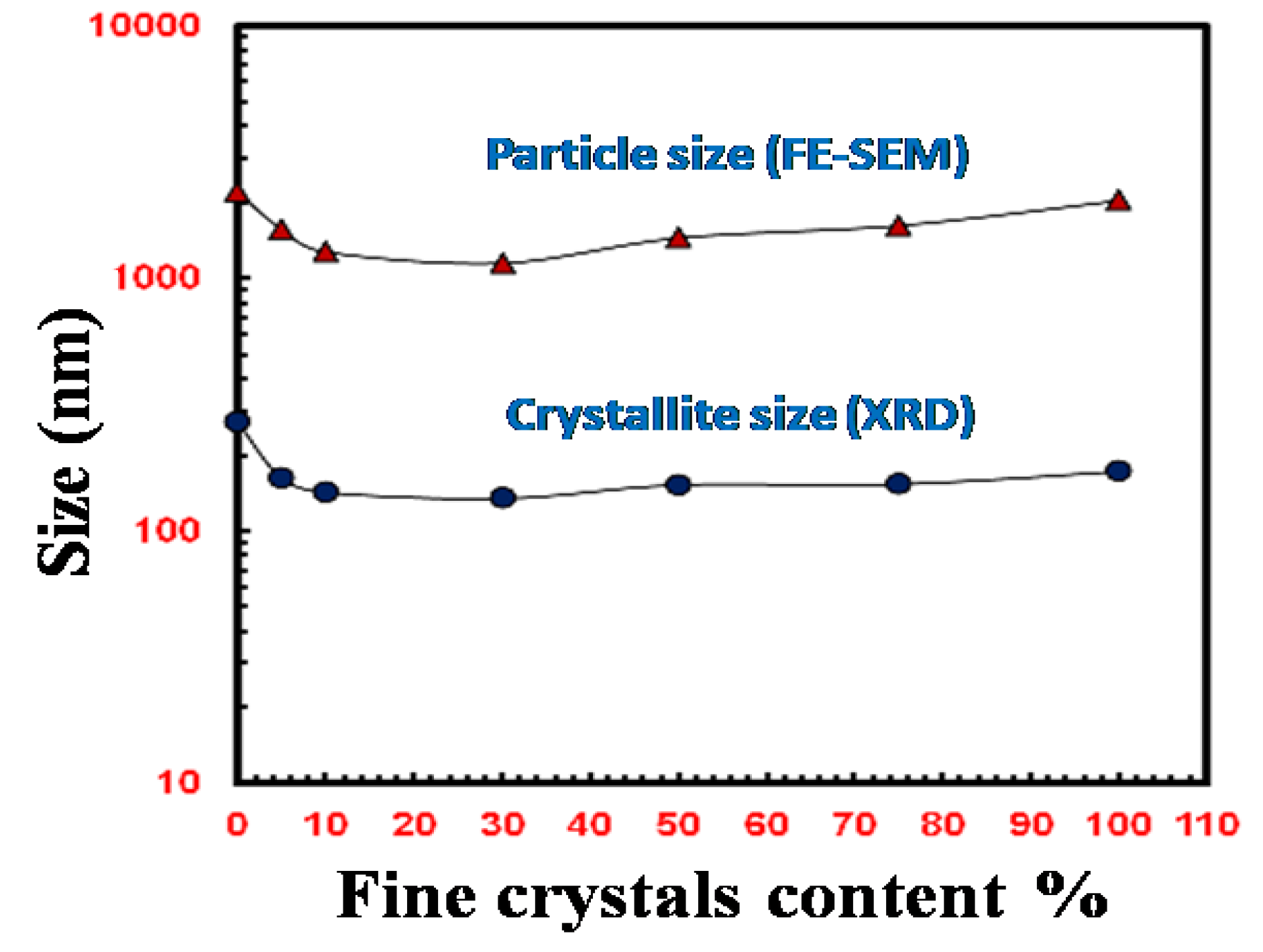
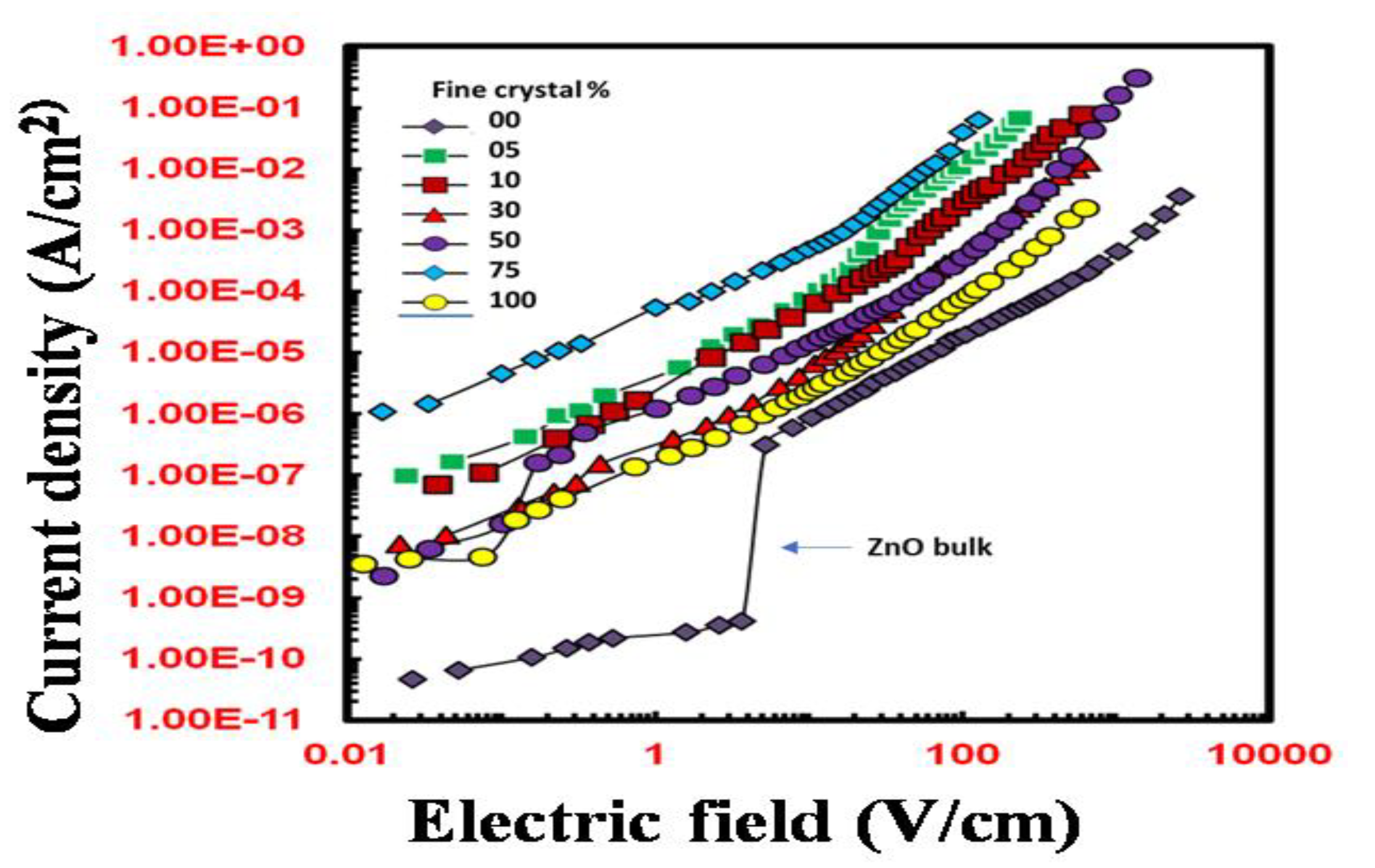
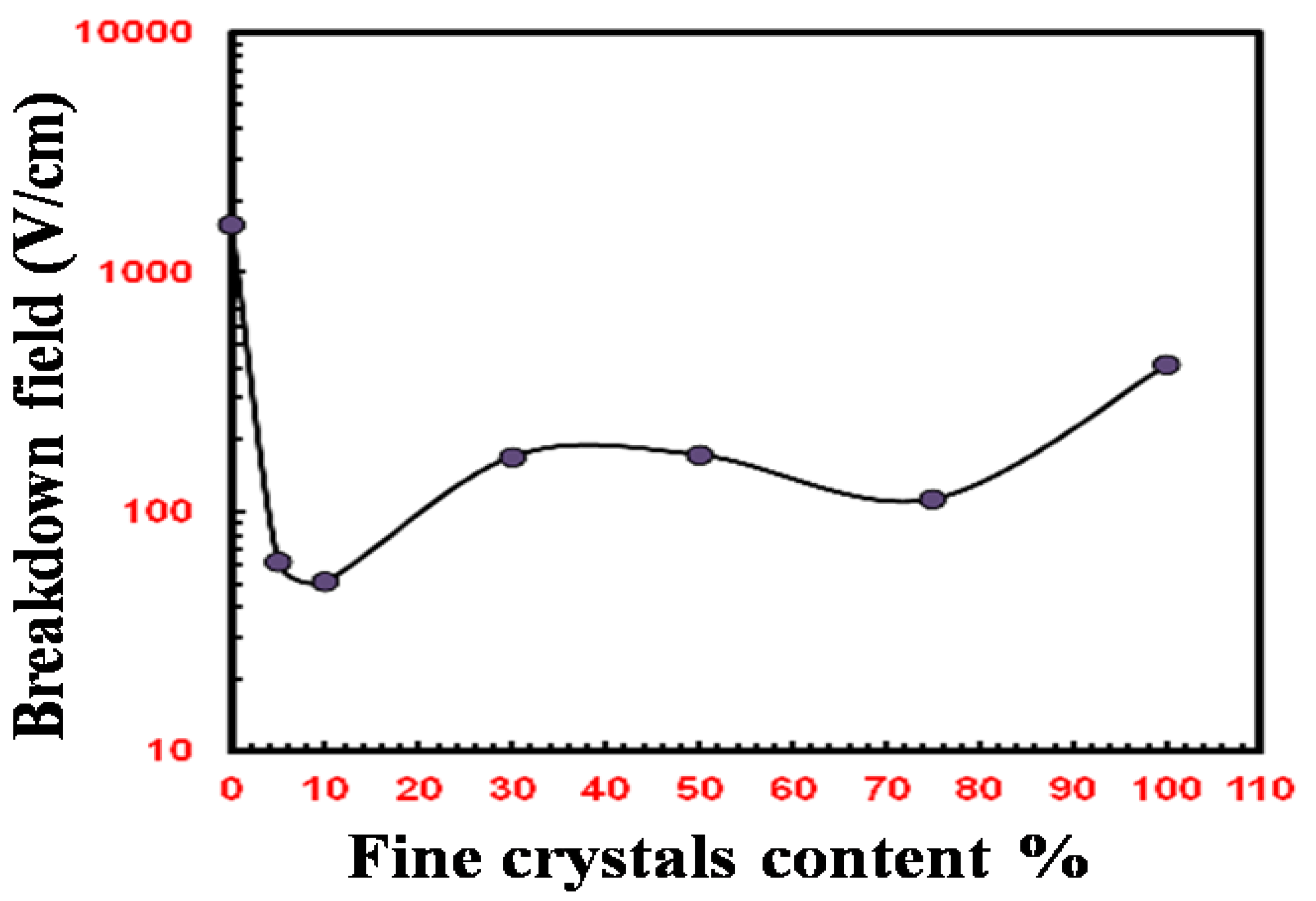
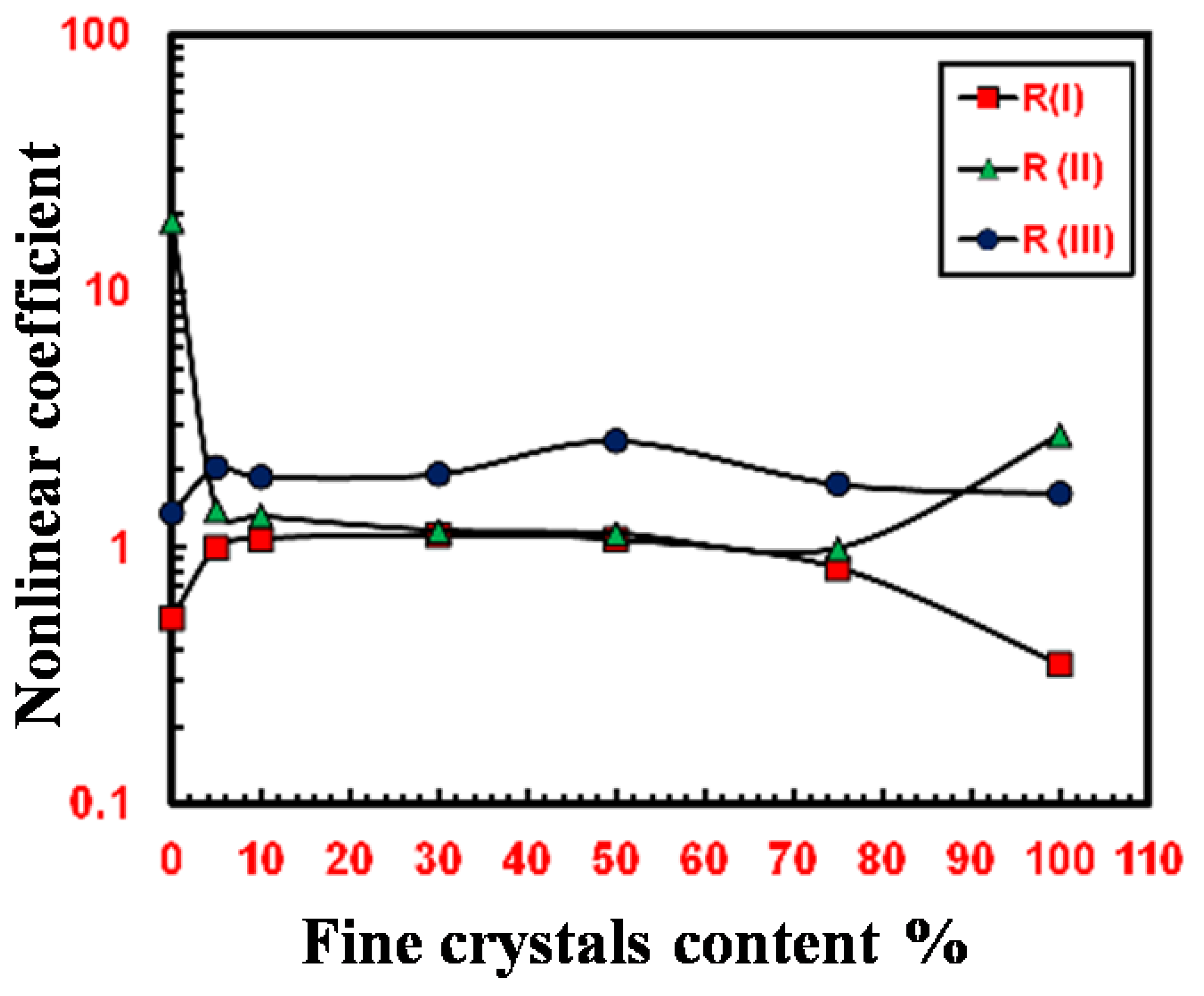
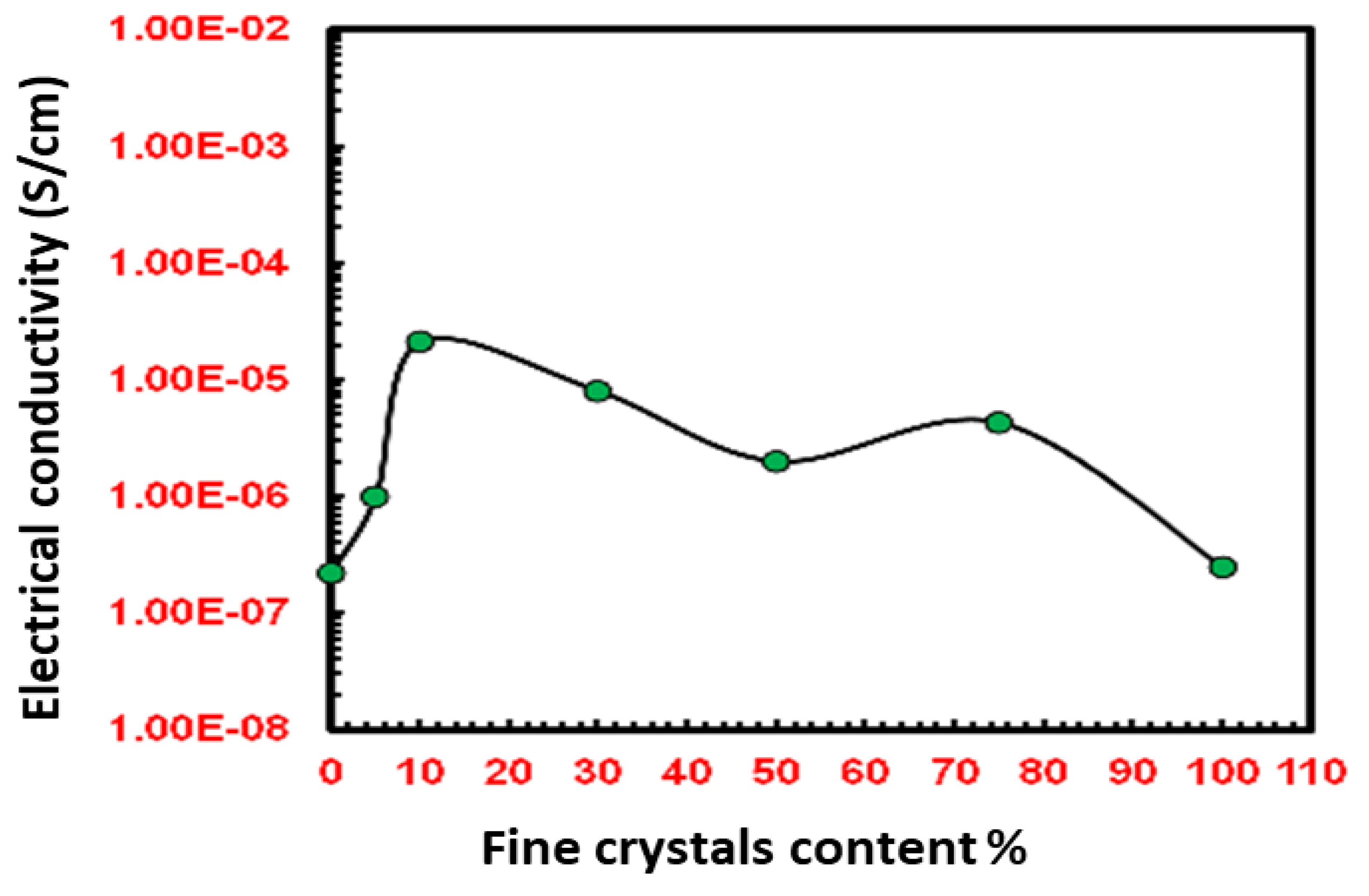
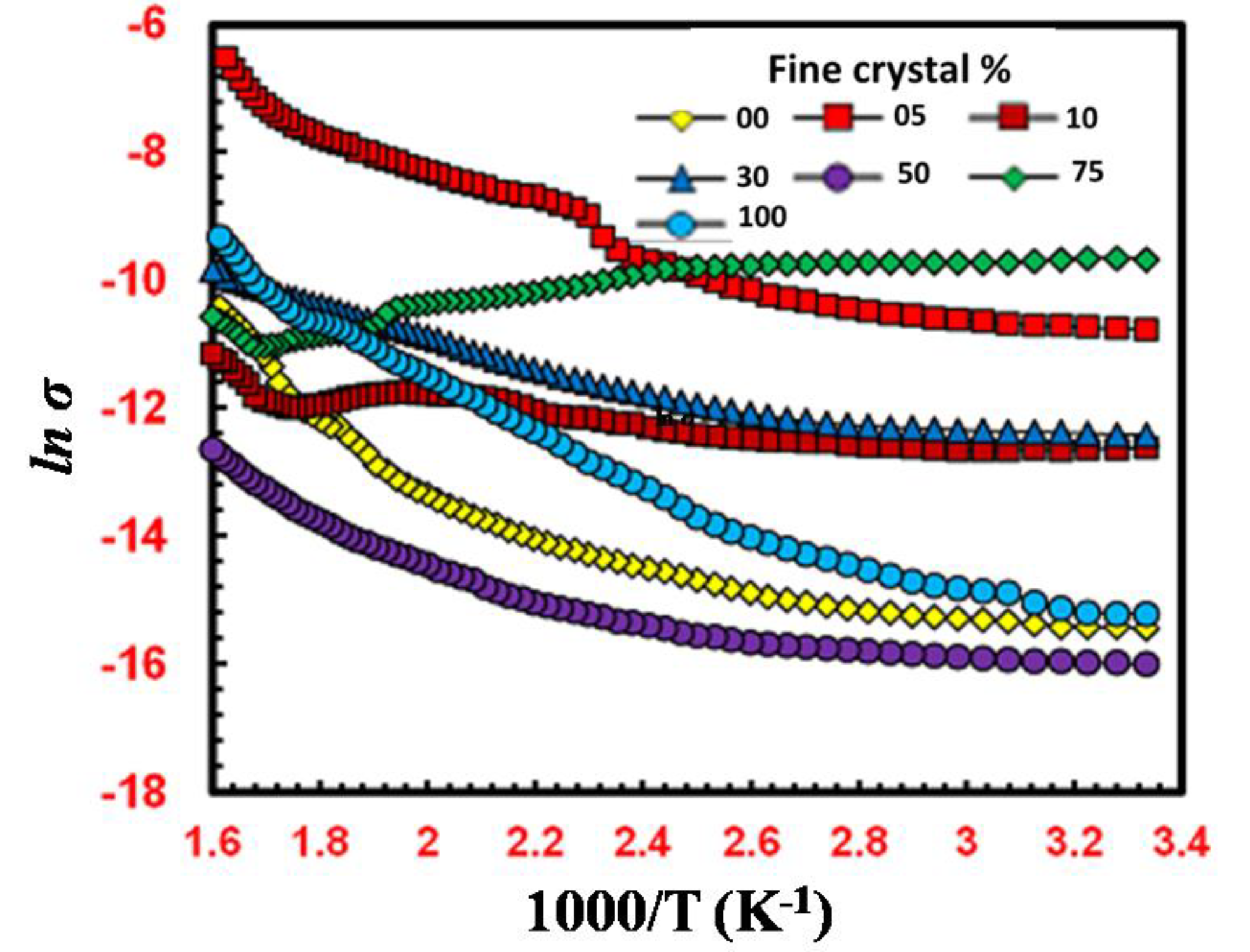
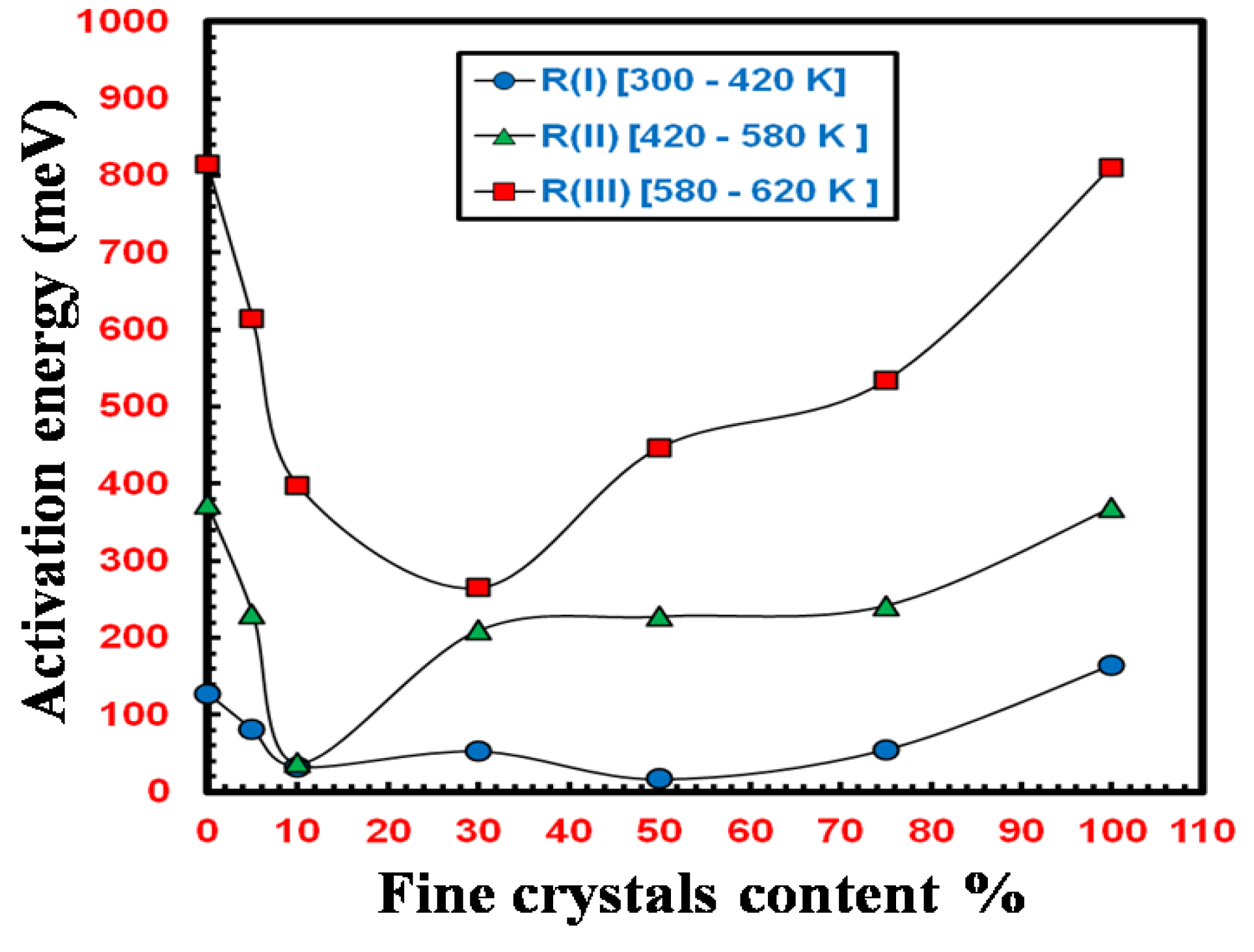
| Fine Crystal Percent | Lattice Parameters | Crystallite Size (nm) | Particle Size (nm) | |
|---|---|---|---|---|
| A (Å) | C (Å) | |||
| 0 | 3.203 | 5.145 | 273 | 2214 |
| 5 | 3.214 | 5.149 | 163 | 1572 |
| 10 | 3.223 | 5.163 | 143 | 1277 |
| 30 | 3.226 | 5.170 | 153 | 1450 |
| 50 | 3.222 | 5.159 | 154 | 1623 |
| 75 | 3.222 | 5.166 | 173 | 2040 |
| 100 | 3.224 | 5.171 | 174 | 1750 |
| Fine Crystal Content (%) | EB (V/cm) | α1 | α2 | α3 |
|---|---|---|---|---|
| 0 | 1580 | 0.53 | 18.6 | 1.36 |
| 5 | 62 | 1.00 | 1.39 | 2.06 |
| 10 | 51 | 1.08 | 1.32 | 1.88 |
| 30 | 170 | 1.11 | 1.16 | 1.93 |
| 50 | 173 | 1.07 | 1.13 | 2.60 |
| 75 | 113 | 0.83 | 0.99 | 1.76 |
| 100 | 410 | 0.35 | 2.75 | 1.62 |
| Fine Crystal Content (%) | σ (S/cm) | Ea (meV) (300–420 K) | Ea (meV) (420–580 K) | Ea (meV) (580–620 K) |
|---|---|---|---|---|
| 0 | 2.20 × 10−7 | 128 | 374 | 815 |
| 5 | 1.02 × 10−6 | 81 | 232 | 614 |
| 10 | 2.11 × 10−5 | 33 | 38 | 398 |
| 30 | 8.00 × 10−6 | 53 | 210 | 265 |
| 50 | 2.06 × 10−6 | 17 | 228 | 447 |
| 75 | 4.31 × 10−6 | 55 | 242 | 534 |
| 100 | 2.47 × 10−7 | 164 | 369 | 811 |
© 2020 by the authors. Licensee MDPI, Basel, Switzerland. This article is an open access article distributed under the terms and conditions of the Creative Commons Attribution (CC BY) license (http://creativecommons.org/licenses/by/4.0/).
Share and Cite
Aljaafari, A.; Sedky, A. Influence of Fine Crystal Percentage on the Electrical Properties of ZnO Ceramic-Based Varistors. Crystals 2020, 10, 681. https://doi.org/10.3390/cryst10080681
Aljaafari A, Sedky A. Influence of Fine Crystal Percentage on the Electrical Properties of ZnO Ceramic-Based Varistors. Crystals. 2020; 10(8):681. https://doi.org/10.3390/cryst10080681
Chicago/Turabian StyleAljaafari, Abdullah, and Ahmed Sedky. 2020. "Influence of Fine Crystal Percentage on the Electrical Properties of ZnO Ceramic-Based Varistors" Crystals 10, no. 8: 681. https://doi.org/10.3390/cryst10080681
APA StyleAljaafari, A., & Sedky, A. (2020). Influence of Fine Crystal Percentage on the Electrical Properties of ZnO Ceramic-Based Varistors. Crystals, 10(8), 681. https://doi.org/10.3390/cryst10080681






